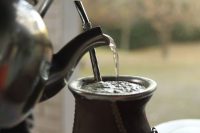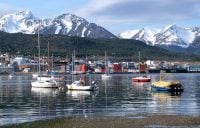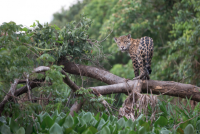
Argentina is home to a huge variety of falls. The most famous waterfall of Argentina without question is Iguazu. It is a magical place. It is worth a visit to Argentina just for this experience.
There are other beautiful waterfalls in Argentina too – stunning, natural cascades in amazing places – just on a smaller scale. Many of the waterfalls in Argentina are accessed via uncrowded and serene hiking tracks and have curious sites to visit along the way.
But first…
Iguazu
Located in the Iguazu National Park on the border of Argentina and Brazil, Iguazu is made up of some 275 separate cataracts spanning 3 kilometers.
The word “Iguazu” means “great water”. It’s an apt description – the continuous spray from the falls produces intense humidity and its own micro-climate in the UNESCO World Heritage Site.
At only 82 meters, Iguazu Falls are not as high as other waterfalls – Victoria Falls in Zimbabwe are 108 meters. Angel Falls in Venezuela, the highest in the world, are over 800 meters!
But the average flow rate of Iguazu is massive at 1,756 cubic meters per second, and they are nearly three times as wide as Niagara Falls.
And where Niagara offers casinos and minigolf, hotels and shopping, Iguazu brims with nature and wildlife – some of it very rare.
Geography of Iguazu
There are two main sections of Iguazu. To the east, a gargantuan curtain of waterfalls includes Salto de San Martin, Salto Mbiguá, and Salto Escondido – each a giant waterfall in its own right.
To the west is the Garganta del Diablo (the Devil’s Throat), a curious horseshoe shaped series of 14 falls, and one of the most spectacular sights on earth. The cascades pound with so much force that they lift a permanent cloud of mist 30 meters in the air.
Amazing hiking trails snake through sub-tropical surroundings. Rainbows form in the afternoons. It can feel like you’re on another planet.
You might see snakes and jaguars, if you’re lucky a Toucan, capuchin monkeys, aracaris or any of the 400 species of birds, 80 types of mammals, and countless insects and reptiles that inhabit the area. Coatimundis (like little racoons but cute) come looking for food in the eating areas.
Tips
· Take insect repellent, the mosquitos are rampant.
· Take a raincoat if you don’t want to get sprayed.
Iguazu Falls Facts
· The boat tours take visitors directly into the path of the spray for a thrill ride.
· Eateries are expensive so some prefer to pack snacks.
· You can take a bus to the Brazilian side of the falls during the day but will need your passport.
What country is Iguazu Falls in?
About 80% of the falls are in Argentina and rest are in Brazil. The Brazilian side affords incredible panoramic views, and has an elevator to the top of the falls where you can walk along the edge. It’s worth visiting both sides if you can.
Iguazu is the ultimate of the South American waterfalls to discover. It is incomparable with any other falls in Argentina or elsewhere, but there are many others in Argentina worth visiting with some beautiful waterfall hikes.
Moconá Falls
The Moconá Falls are located 350 kilometers from Iguazu in the Moconá Provicial Park in Misiones. These falls are a natural wonder in their own right. They have the peculiarity of running parallel along the Uruguay River for around 2 kilometers from start to finish, forming a natural border between Argentina and Brazil. They only reach a height of 3 to 4 meters on average depending on the year and rainfall, but it is the unusual length of these cataracts that is their draw.
Tips
- The visitor center in the park arranges boat trips to see the falls every 15 minutes.
- Inside the park there are some easy jungle trails to explore, including trails such as Chachí (only 1800 meters and low difficulty) and La Gruta (medium difficulty and only a 600-meter distance).
Colorado River Falls
Another unforgettable experience are the waterfalls of the Colorado River in Cafayate. This is a mid-to-difficult level hiking trail of 3.5 hours to complete or a full day with swim stops. You will find a series of cascades along the track which can be demanding in places (some quite steep rock climbing involved to access some parts), but worth it, especially in the warmer months when you can stop and swim. (You can do a shorter route and visit three waterfalls or the full length of seven). The track ends at the top of a hill with lovely views of Cafayate below. Guides are recommended as the trail is not marked. You can organize one ahead of time or they can be found on site but have mixed reviews. Check rates before committing.
Tips:
· Wear good-grip hiking shoes for this one.
· Take water and food.
· Take a swim suit. The water is cold, but refreshing and pleasant if you do the trail in the summer months.
Los Alerces Falls
San Carlos de Bariloche is known in part for its waterside setting and surrounding lakes. The pathway to this Argentinian waterfall is beautiful if not well-maintained. Nevertheless, it’s worth the trouble to see the powerful waterfall at the end. The color of the water is sublime on a sunny day, and the waterflow is powerful.
Nahuel Huapi national park
To get there head to the entrance of the Nahuel Huapi national park. The trail takes you several kilometers along rapids, lagoons and lovely places to stop and enjoy the unspoiled nature without disturbances.
The views along the rapids include the Los Moscos lake from above, the Hess lake bridge and there are stunning views of the Tronador mountain.
Tips
· The best time to go is spring on a sunny day.
· Take insect repellent or full body cover for the horseflies and other bugs.
· Track is not maintained and can be rough.
· Restricted entry times.
· Takes about 1.5 hours there and back.
No comments yet
There are no comments on this post yet.




Leave a comment